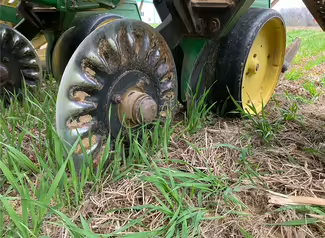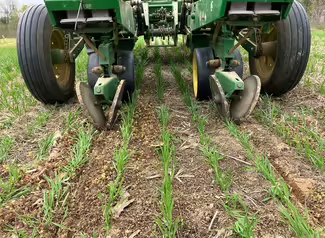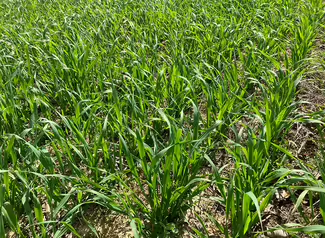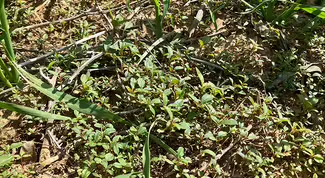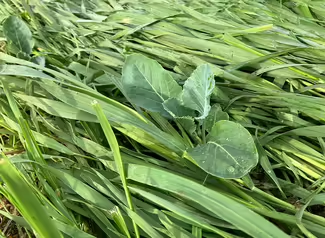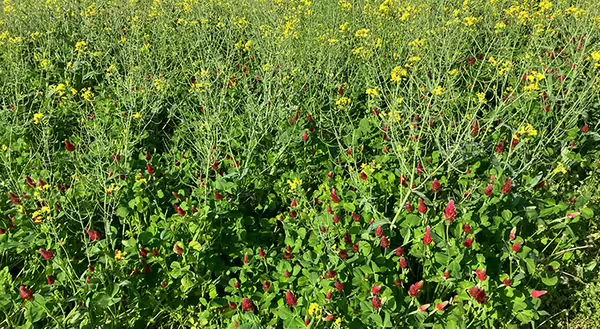
Cover crops are always on the move in April. I said “explosion” because for many overwintering cover crops it is almost that. Some can grow over 1” or more per day this time of year!
Fall Cover Crop Mixtures
Here is a quick update on some early fall planted spring oats, crimson clover, and rapeseed (25/6/2 lb/A, respectively) in a few areas including some planted after potato harvest last year. I shared this last month and have included another picture of how the stand looks now. The rapeseed bloomed first, followed by the crimson clover. The pollinators loved this cover and it’s certainly pretty and would turn some heads with a large field like this! This area is going to be in a state of “covered” fallow this season and now that this mix has hit its peak, its time to think about to seed next. I haven’t decided but probably a mix of cowpeas with some grass like pearl millet and maybe some other things in the mix. Stay tuned for next month to see what I decide!
Spring Cover Crop Experimenting
My spring cover crop “experimenting” I mentioned last month is starting to take off. As a refresher, this year I have about an acre at our local demonstration farm, the Baebler Educational Farm, south of Waterloo which will be planted into multiple planting dates of field and sweet corn for a youth ag camp. I no-till drilled spring oats and Austrian winter peas (target 50/20 lb/A, respectively) on 3/5/24.
I no-till planted the first corn planting on 4/9/24 into the green cover. I terminated the cover with a burndown of glyphosate & 2,4-D with atrazine & s-metolachlor (Dual II Magnum) the day after planting. At that point the cover was still fairly small, maybe 4 to 6 inches tall. I didn’t expect much in the first month of growth, but it did make for nice planting.
Personally, I would take this approach over trying to work the soil to a good condition and then trying to plant. That would have required at least two more field passes with tillage equipment and probably not ended up with any better stand or result. The planting and spraying pass would have happened either way so two passes vs. four-plus passes and the time and fuel. There is plenty of work in the spring when the weather is fit so I would take that tillage time and invest it somewhere else! Also, it would have left the soil very vulnerable to erosion from recent rains. The corn is up now and looking good!
The remaining cover for later plantings is looking good. I mentioned an area of fall, interseeded balansa clover that I did not kill off when planting the oats and peas. The balansa did thrive but with lots of winter annual pressure, the spring planted covers were under heavy competition. The planted cover is not as clean as the other areas. I have noticed some first germination of waterhemp starting in the oats/peas in places, while the area with the winter annuals, clover and oats/peas has not shown any signs of waterhemp yet.
Transplanting “Green”
I have a small area for mixed summer vegetables that I have in a mixture of fall-planted cereal rye and barley. I terminated a strip (glyphosate & s-metolachlor {Dual Magnum]) of this area the day before and transplanted some cauliflower and broccoli 4/18/2024. The cover crop has now died down and cole crops are thriving!
Management Thoughts for the Month
Think about seed formation on cover crops and when you want to terminate. Seed formation isn’t always a bad thing and sometimes it actually can be beneficial, but leave the ball in your court for what you want to go to seed or not. Mowing, roller crimping, and/or an herbicide application can all be great tools to knock back your cover crop before any mature seed is formed.
Also, what early crops do you have planted? Do you have any times after that crop you can fill in with a cover crop? Buckwheat is always a great short-term summer cover that can fill about 40 days before any seed formation. For more ideas on this or anything else cover crop related check out the Midwest Cover Crops Council Selector Tool to get some inspiration on some cover crops that might thrive in your area planted this spring and early summer.
Photo credits: N. Johanning Illinois Extension 2024
